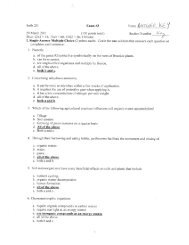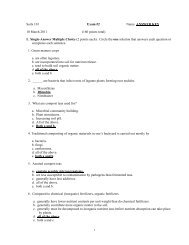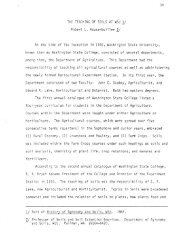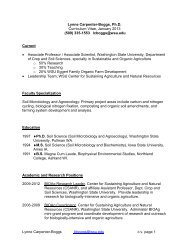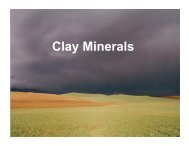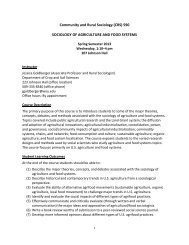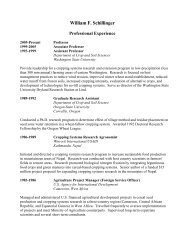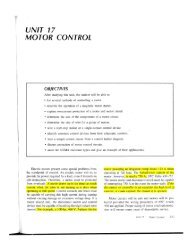2012 Dryland Field Day Abstracts - Dept. of Crop and Soil Sciences ...
2012 Dryland Field Day Abstracts - Dept. of Crop and Soil Sciences ...
2012 Dryland Field Day Abstracts - Dept. of Crop and Soil Sciences ...
You also want an ePaper? Increase the reach of your titles
YUMPU automatically turns print PDFs into web optimized ePapers that Google loves.
Part 1. Breeding, Genetic Improvement, <strong>and</strong> Variety Evaluation Page 25<br />
(http://variety.wsu.edu). Oral presentations, field days, <strong>and</strong> industry<br />
<strong>and</strong> extension meetings are other means used for delivering research<br />
results. Results from the Extension Variety Testing Program provide<br />
independent assessment <strong>of</strong> variety performance to support variety<br />
selection decisions by growers <strong>and</strong> for other decisions by other<br />
clientele. Growers can realize a timely economic payback using<br />
information from yield <strong>and</strong> variety performance data that is provided<br />
within days after harvest via an email list-serve. This project is made<br />
possible by contributions <strong>of</strong> l<strong>and</strong> <strong>and</strong> time from farmer cooperators<br />
where trials are located, <strong>and</strong> cooperators at the WSU research units<br />
at Pullman <strong>and</strong> Lind. Partnerships with research scientists from public<br />
<strong>and</strong> private sectors are vital to make this program successful. Funding<br />
is provided by: Washington Grain Commission, Dry Pea <strong>and</strong> Lentil<br />
Council, WSU Agricultural Research Center, <strong>and</strong> Washington State<br />
<strong>Crop</strong> Improvement Association.<br />
Modification <strong>of</strong> Coleoptile Length in Wheat Via Manipulation <strong>of</strong> the AHL Gene Family<br />
Michael M. Neff, David Favero, Pushpa Koirala, Jiwen Qiu <strong>and</strong> Jianfei Zhao<br />
<strong>Dept</strong>. <strong>of</strong> <strong>Crop</strong> <strong>and</strong> <strong>Soil</strong> <strong>Sciences</strong> <strong>and</strong> Molecular Plant <strong>Sciences</strong> Graduate Program, WSU<br />
In low rainfall, dryl<strong>and</strong>-cropping areas <strong>of</strong> Eastern Washington st<strong>and</strong> establishment can have a major impact on yields <strong>of</strong> winter<br />
wheat. The problem is especially prevalent in these areas as winter wheat is generally planted in the last part <strong>of</strong> August or early in<br />
September. During dry years these seeds need to be planted in deep furrows (up to 8”) so that the developing seedling has access<br />
to ground water. To facilitate st<strong>and</strong> establishment, wheat breeders have been trying to develop varieties with long coleoptiles as<br />
seedlings while maintaining a high-yielding semi-dwarf stature as adults. Unfortunately, few mechanisms have been identified that<br />
uncouple the semi-dwarf phenotype <strong>of</strong> adult plants with reduced elongation <strong>of</strong> the coleoptile in seedlings. The Neff lab has<br />
identified a group <strong>of</strong> plant-specific genes that, when mutated in a particular way, uncouple seedling elongation from adult size.<br />
These genes encode AHL (AT-Hook Containing, Nuclear Localized) proteins have two domains. One domain, the AT-Hook, binds ATrich<br />
regions <strong>of</strong> DNA. The second domain is involved in protein/protein interactions.<br />
This project includes three main objectives: 1) to identify AHL family members in wheat, 2) to identify those genes that are<br />
expressed at high levels in the coleoptile, <strong>and</strong> 3) to examine the role <strong>of</strong> both wild type <strong>and</strong> mutant genes on coleoptile elongation.<br />
In addition to the identification <strong>of</strong> many partial AHL sequences, we have cloned four full-length AHL sequences from the wheat<br />
genome <strong>and</strong> named them Taq1, Taq2, Taq3, <strong>and</strong> Taq4. These sequences were identified using a combination <strong>of</strong> comparative<br />
genomic <strong>and</strong> PCR cloning techniques. The four wheat AHL sequences were constructed into both prey <strong>and</strong> bait vectors for yeasttwo-hybrid<br />
analysis, which allows us to test protein-protein interactions amongst the family members. The results show that the<br />
wheat AHL proteins Taq2 <strong>and</strong> Taq3 interact to each other. We have also shown that Taq2 <strong>and</strong> Taq3 can also interact with the<br />
Arabidopsis AHL SOB3 protein. These results strongly suggest that the biochemical function <strong>of</strong> AHL proteins can be conserved<br />
between dicot <strong>and</strong> monocot species. RT-PCR reactions have been done for Taq2, Taq3 <strong>and</strong> Taq4 at early stages <strong>of</strong> plant<br />
development. In addition to confirming expression <strong>of</strong> each gene in coleoptiles, the results revealed differential expression patterns<br />
for Taq2, Taq3, <strong>and</strong> Taq4 in the early stages <strong>of</strong> wheat seedling development. Immature wheat embryos (14-16 days after<br />
flowering) were used as explants to induce callus for transformation <strong>of</strong> mutant <strong>and</strong> wild type wheat AHL sequences (Figure 1). This<br />
transgenic approach will allow for phenotypic analysis <strong>of</strong> agronomic traits for wheat expressing different forms <strong>of</strong> these genes.<br />
Fig. 1. Wheat callus used for transformation <strong>of</strong> wildtype <strong>and</strong> mutant forms <strong>of</strong> AHL genes. Close<br />
up (left). Growth chamber with many wheat transformation experiments (right).




